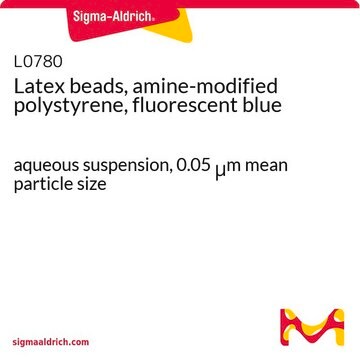66019
Nano beads based on polyacrylonitrile, Chromeon 642-marked, carboxylated
Sinonimo/i:
PAN-Chromeon 642, carboxylated
Autenticatiper visualizzare i prezzi riservati alla tua organizzazione & contrattuali
About This Item
Codice UNSPSC:
12352200
Stato
liquid
Concentrazione
0.5%
Diametro medio
80-100 nm
Fluorescenza
λex 642 nm; λem 677 nm in H2O
Temperatura di conservazione
2-8°C
Applicazioni
Nanobeads based on polyacrylonitrile, Chromeon 642-marked, carboxylatedis an effective vehicle for energy transfer with external fluorescent dyes and embedded dyes making them useful in FRET-based immunoassay applications such as protein nanoarray and quantum dot assays.
Codice della classe di stoccaggio
12 - Non Combustible Liquids
Classe di pericolosità dell'acqua (WGK)
WGK 3
Punto d’infiammabilità (°F)
Not applicable
Punto d’infiammabilità (°C)
Not applicable
Dispositivi di protezione individuale
Eyeshields, Gloves
Scegli una delle versioni più recenti:
Possiedi già questo prodotto?
I documenti relativi ai prodotti acquistati recentemente sono disponibili nell’Archivio dei documenti.
I clienti hanno visto anche
Hye-Young Park et al.
Langmuir : the ACS journal of surfaces and colloids, 26(10), 7327-7333 (2009-12-25)
The generation of compact quantum dots (QDs) probes is of critical importance for visualizing molecular interaction occurring in biological context, particularly when using the Förster resonance energy transfer (FRET) approach. This Article reports novel water-soluble compact CdSe/ZnS QDs prepared by
R Bruck et al.
Biosensors & bioelectronics, 26(9), 3832-3837 (2011-03-23)
We report the development of a Mach-Zehnder interferometer biosensor based on a high index contrast polymer material system and the demonstration of label-free online measurement of biotin-streptavidin binding on the sensor surface. The surface of the polyimide waveguide core layer
Phat L Tran et al.
Analytical and bioanalytical chemistry, 398(2), 759-768 (2010-07-24)
An alternative approach for fabricating a protein array at nanoscale is suggested with a capability of characterization and/or localization of multiple components on a nanoarray. Fluorescent micro- and nanobeads each conjugated with different antibodies are assembled by size-dependent self-assembly (SDSA)
Il team dei nostri ricercatori vanta grande esperienza in tutte le aree della ricerca quali Life Science, scienza dei materiali, sintesi chimica, cromatografia, discipline analitiche, ecc..
Contatta l'Assistenza Tecnica.
